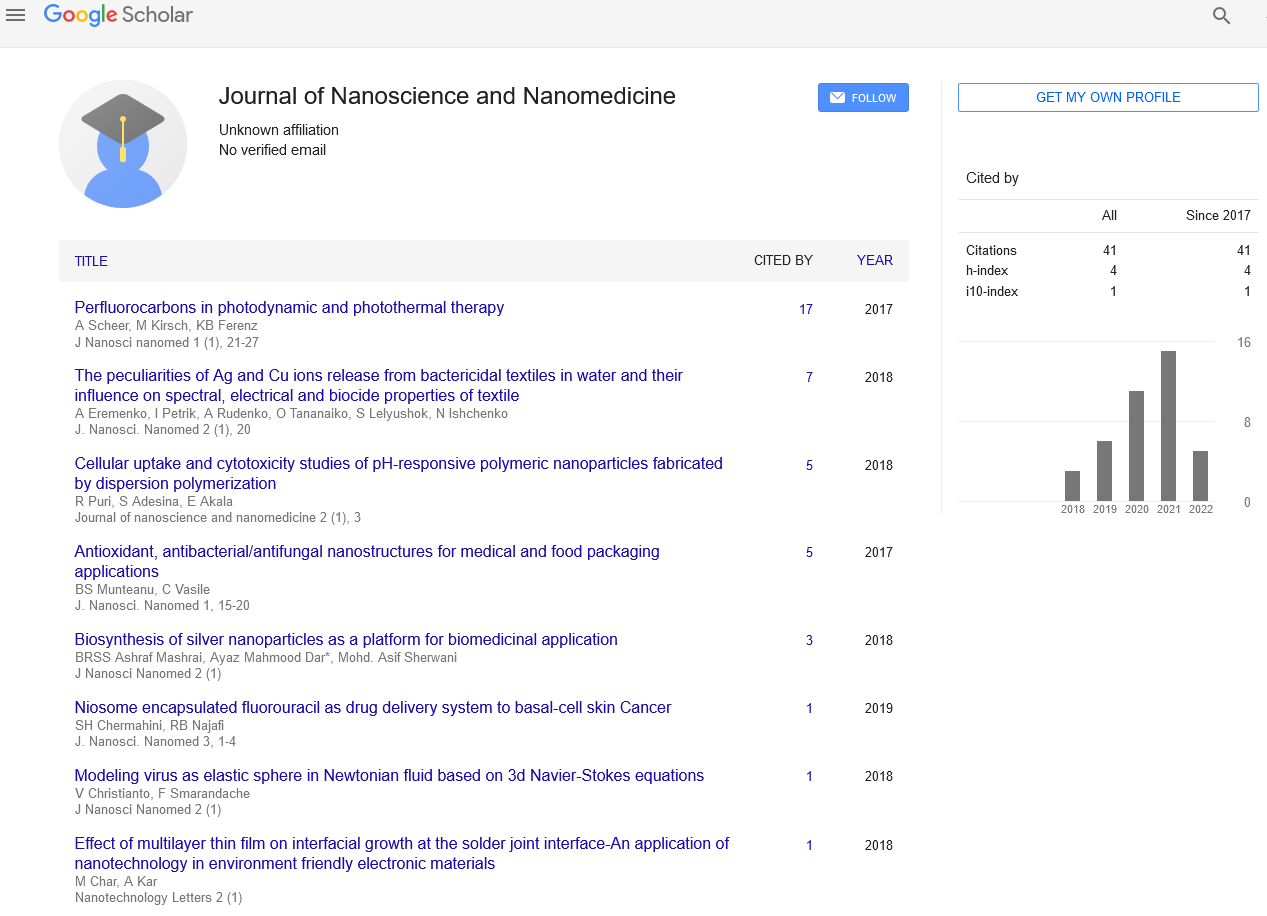Impact of Nano-ZnO Particle Suspension on Plants
Received: 01-May-2021 Accepted Date: May 14, 2021; Published: 21-May-2021
Citation: Arenal S. Impact of Nano-ZnO Particle Suspension on Plants. J Nanosci Nanomed 2021;5(3):5.
This open-access article is distributed under the terms of the Creative Commons Attribution Non-Commercial License (CC BY-NC) (http://creativecommons.org/licenses/by-nc/4.0/), which permits reuse, distribution and reproduction of the article, provided that the original work is properly cited and the reuse is restricted to noncommercial purposes. For commercial reuse, contact reprints@pulsus.com
Abstract
Nanotechnology could be a flexible field and has found application in nearly all the existing areas of science. The utilize of nano-particles in plant growth and for illness control could be a later hone. The blend of nano-SiO2 and nano-TiO2 supposedly increments nitrate reeducates action in soybean seeds subsequently increments seed germination and development. Nano-functionalized carbon nanotubes improved root prolongation in onion and cucumber.
Keywords
Nanotechnology, Nano-functionalized carbon nanotubes, Nano-particles.
Introduction
The effect of nano-particles (NPs) on development of higher plants has scantly been detailed. An examination was carried out to consider the impact of zinc oxide nano-particles (<100 nm) on development of maize (Zea mays L.) plant, as one of the major rural crops, in a arrangement culture framework. Different concentrations of zinc (Zn) were connected through nano-zinc oxide (ZnO) particles (<100 nm) in suspension frame and in ionic frame through zinc sulfate (ZnSO4) salt in Hoagland arrangement culture. Exploratory comes about appeared that nano zinc oxide particles may improve and keep up the development of maize plant as well as routine Zn fertilizer (as ZnSO4) [1].
The plant parameters like plant stature, root length, root volume, and dry matter weight were all made strides due to application of zinc oxide nanoparticle. These discoveries show that plant roots may have the extraordinary system of acclimatizing nano-Zn and utilizing for its development and improvement. Diverse enzymatic exercises were likewise examined and test results uncovered that nano-ZnO particles (<100 nm) additionally administered the enzymatic movement of maize plant. A different research facility test was likewise completed to describe the zinc oxide nano molecule for its size, zeta potential, and so forth [2].
Nano-ZnO particles on development in plant agar media to forestall precipitation of water insoluble nanoparticles in test units. Different centralizations of nano-ZnO particles in suspension structure were acquainted with the agar media and its impact on root and shoot development of seedlings inspected. Scientific strategies like optical microscopy and filtering electron microscopy were utilized to consider the design of root. Inductive coupled plasma (ICP) was utilized to decide the take-up of nano-ZnO particles by root [3].
The best reaction of nano-ZnO on mung bean was seen at 20 ppm and on chickpea at 1 ppm, past these focuses the seedling showed impediment in development and advancement in this manner proposing the poisonous impact of nano-ZnO particles [3].
Nano-ZnO has broadly been utilized in industry for quite a few years. Nonetheless, no examination has been utilized nano-Zn in farming. Zinc is one of the plant miniature supplement and its phytotoxic impacts are known. The current investigation manages the impact of nano-ZnO molecule suspension, as miniature supplement, on the development of seedlings at different focuses.
Zinc oxide nanoparticles are nanoparticles of zinc oxide (ZnO) that have distances across less than 100 nanometers. They have a expansive surface range relative to their estimate and tall catalytic action. The precise physical and chemical properties of zinc oxide nanoparticles depend on the diverse ways they are synthesized [4].
ZnO nanoparticles have diverse shapes (rod-like, star-like and isometric) and a wide measure dissemination extend of 30–150 nm. The ZnO particles were display basically as clusters. ZnO nanoparticles have diverse shapes (rod-like, star-like and isometric) and a wide measure dispersion run of 30–150 nm.
The good thing about nano-zinc is that the particles retain UV light and diffuse obvious light, giving more prominent SPF - whereas somewhat bigger Non-nano particles offer more prominent UVA security - so the combination delivers a tall SPF rating in conjunction with UVA security [4, 5].
Conclusion
The increment in biomass at certain focus proposes the ideal rest limit for the development of seedlings. Anyway decline in biomass past this fixation proposes the poisonous impact of nano-ZnO particles. The viable development at ideal focuses and repressed development past these might be credited to the aggregation and take-up of nano-ZnO molecule by the roots.
REFERENCES
- Cañas, J.E, Long M, Nations S et al. Effects of functionalized and nonfunctionalized single-walled carbon nanotubes on root elongation of select crop species. Env Tox Chem. 2008;27:1922-1931.
- Galbraith D.W. Silica breaks through in plants. Nature Nanotechnology. 2007;2:272-273.
- Hong F.S, Yang F, Liu C et al.. Influence of nano-TiO2 on the chloroplast aging of spinach under light. Bio Trace Element Res. 2005;104: 249-260.
- Lin D, Xing B. Phtytotoxicity of nanoparticles: Inhibition of seed germination and root growth. Env Poll. 2007;150:243-250.
- Lin D, Xing B. Root uptake and phytotoxicity of ZnO nanoparticles. Env Sci Tech. 2008;42:5580-5585.





